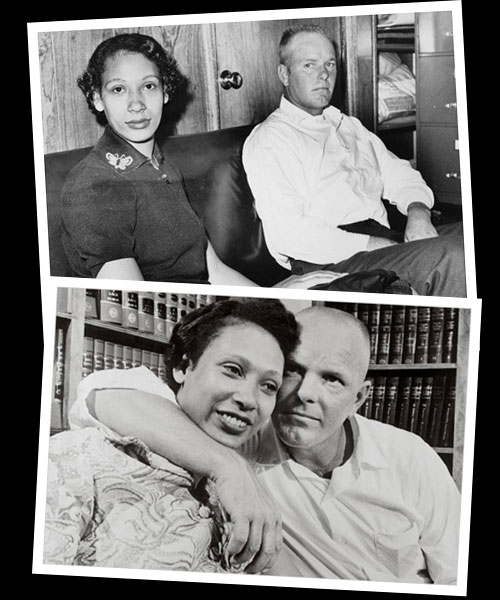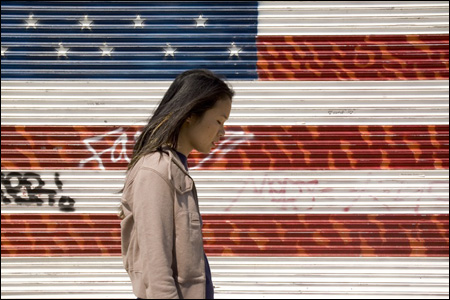Mixed Dreams:
Exploring “Multi” Experiences in the U.S.
Exploring “Multi” Experiences in the U.S.
EXCO Spring 2011, Oberlin College
Instructor: Nicole Asong Nfonoyim
The experiences and identities of mixed-race people in the United States have often been marginalized if not rendered invisible, silenced and subsumed under the dominant black-white binary. While mixed identities have been part of U.S. history since the nation’s birth, the year 2010 marked only the second time in U.S. history that Americans will be able to check more than one racial/ethnic category in the census. From the overwhelming 6.8 million individuals who checked “more than one box” in the 2000 U.S. Census to the election of President Barack Obama (a self-proclaimed “mutt”)—“multi”* Americans are gaining unprecedented visibility in the 21st century. With this visibility, however comes inevitable scrutiny and ambivalence as evidenced by debates over Obama’s racial identity as well as the mixed racial ancestry of the growing number of U.S-born Latino/as who are gaining considerable social and political ground. With a nation so obsessed with race and yet as intent on hastening a post-racial era on the backs of Americans of color, re-imagining conceptions of race and mixed identities has never been more important. This course will provide an introduction to contemporary discussions, debates and narratives surrounding multi America. By reading and discussing scholarly, literary, editorial, and visual texts we will critically examine the spaces multi people occupy in the U.S. as well as the identity politics and perspectives that mark these experiences. We will also explore the growing narratives and spaces being created to build communities and express multi subjectivities. Through class discussions, assignments and a final project, students will also be encouraged to explore their own identities and subjectivities as they relate to larger discourses and narratives around race and intersecting identities.
* “Multi” is a term used to describe people with mixed ancestry be they bi- or multi-racial/ethnic/religious as well as transnationally and/or transracially adopted. The use of this term will be discussed in greater depth during the first class.
Class Requirements
Attendance & Participation: Since much of the class involves close reading and group discussion it is very important that you come to class having done the readings and are a present and active participant. No more than three absences will be allowed. Please contact me as early as possible about any absences.
Evaluation: * Reflection paragraph on Maria P.P. Root’s Bill of Rights for Racially Mixed People
* In-class Presentation on popular culture and media images of multi people and/or families.
* Final Project (written, visual, oral, mixed-media, presentation etc)creating personal narratives of origins and identity.
Course Materials
Required Texts: Copies of all reading materials will be provided in electronic pdf form each week. It is your responsibility to print these readings out. Some materials will also be available on reserve in the Multicultural Resource Center Library. There are no fees for this course
Visual Materials: We will be watching all of the visual materials in class with the exception of an optional screening of Mira Nair’s Mississippi Masala on Sunday, Feb. 21st @ 7pm in WIlder 208.
Class Dynamics
The dynamics of the class will be based on group discussions focused on the readings for the week that highlight a wider set of issues. The first quarter of the class will be lecture-based and the rest will be discussion-based. Lectures are simply a way to ground some of the topics for the week and fill in some gaps not developed through the reading. Ultimately, class should be a safe, productive and creative space to discuss and express ideas and thoughts on the range of topics presented in this course.
Course Outline
Week 1: What Are You?: “Multi” Americans (FEB 16th)
Discussion Questions: How can we conceptualize and understand “mixed” identity? How has “mixed” identity been defined/denied at different points in U.S. history? Who is considered “mixed”/ “multi”? What is the role of “power/privilege” in claiming a mixed identity? - Cynthia L. Nakashima. An Invisible Monster: The Creation and Denial of Mixed Race People in America
- R. L’Heureux Lewis & Kanika Bell. Negotiating Racial Identity and Social Interactions
In Class: Maria P.P. Root. Bill of Rights for Racially Mixed People, selected clips from Imitation of Life (7min), New Demographic: Cute But Confused Video, NTY Video
--------------------
 Week 2: Illicit Desire: Miscegenation Laws, Citizenship & Constructing a (White) Nation (FEB 23rd) .
Week 2: Illicit Desire: Miscegenation Laws, Citizenship & Constructing a (White) Nation (FEB 23rd) . Discussion Questions: Who/what did anti-miscegenation laws seek to protect? Why? How did anti-miscegenation laws police claims to citizenship and belonging by people of color and mixed-race descendents? What role does gender/sexuality play in issues surrounding miscegenation?
- Eva Saks. Representing Miscegenation Law
- Christine B. Hickman. The Devil and the One Drop Rule
- Cheryl I. Harris. Whiteness as Property
- Karen M. Woods. A “Wicked and Mischievous Connection” The Origins of Indian-White Miscegenation Law
- Leti Volpp. American Mestizo: Filipinos and Anti-Miscegenation Laws in California
-------------------
Week 3: Colonialism, War and the (Sex) Acts of the Forefathers: Lessons from Vietnam (MAR. 2nd)

Discussion Questions: Apply Levi and Valverde’s articles to the film Daughter from Denang: Does the United States have an “obligationto Amerasians”? What is the relationship between the sex “acts” of U.S. military personnel in Asia and acts of colonization, domination, violence and war?
- Robin S. Levi. Legacies of War: The United States’ Obligation to Amerasians
- Kieu-Linh Caroline Valverde. From Dust to Gold: The Vietnamese Amerasian Experience
In Class: Watch clip of “Daughter from Denang” [2002]
--------------------
Week 4: (Dis)Appearing Acts: Transnational & Transracial Adoption (MAR. 9th)
Discussion Questions: How are transnational and transracially adopted individuals included in discussions around mixed identities? What role do desires for “home,” “family” “origins,” and “history” play in the lives of adoptees? What role do politics and (inter)national policies play in the lives of transnational adoptees?
 - Jen Graves. Black Kids in White Houses: On Race, Silence and the Changing American Family
- Jen Graves. Black Kids in White Houses: On Race, Silence and the Changing American Family- National Association of Black Social Workers. “Position Statement on Trans-Racial Adoption” (September 1972)
- Adoptees of Color Roundtable. “Statement on Haiti” (2009)
* Optional Reading: Jeni C. Wright. "Love is Colorblind: Reflections of a Mixed Girl" in Outsiders Within: Writing of Transracial Adoption
In Class: Watch Barbara Lee’s film “Adopted”
----------------------------
Week 6: Mixed Is/Mixed Ain’t: Self-Image & Identity Politics (MAR. 16th)
Discussion Questions: What role do “passing”, “ambiguity” and “power/privilege” play in
 self-identifying as mixed? How have histories of racialization and oppression silenced multi narratives and subjectivities? How and why are claims to mixed identity or heritage policed?
self-identifying as mixed? How have histories of racialization and oppression silenced multi narratives and subjectivities? How and why are claims to mixed identity or heritage policed?- Carla Bradshaw. Beauty & the Beast: On Racial Ambiguity
- Claire Huang Kinsley: Questions People Have Asked Me, Questions I Have Asked Myself
- Claire Huang Kinsley: Questions People Have Asked Me, Questions I Have Asked Myself
- Gloria Anzaldua. La Conciencia de la Mestiza: Towards a New Consciousness
* Optional Reading: Danzy Senna. Mulatto MilleniumIn Class: Watch Bi-Racial Hair poem/short (5min), Mixed Me
--------------------------------
Week 5: The Multiracial Movement (MAR. 23rd)
Discussion Questions: What is the “mixed race movement”? What are the strengths and limitations to claiming a “multi” or “mixed” identity?
- Ramona Douglass. The Evolution of the Multiracial Movement
- G. Reginald Daniel. Race, Multiraciality, and the Neoconservative Agenda
- Eileen T. Walsh. Ideology of the Multiracial Movement: Dismantling the Color Line and Disguising White Supremacy?
- Kim M. Williams. Linking the Civil Rights and Multiracial Movements
------------------
SPRING BREAK!!!
------------------
Week 7: Chilindians, Caublasians & Egiptoricans: Narratives of (Re)Naming (APR. 6th)
Discussion Questions: How do naming and language play a role in building community and identity formation?
 - Thea Lim. New Words for Mixed Race People of Color—With or Without White Ancestry
- Thea Lim. New Words for Mixed Race People of Color—With or Without White Ancestry - Daniel A. Nakashima. A Rose By Any Other Name: Names, Multiracial/Multiethnic People and the Politics of Identity
In Class: Watch “Domino” clip
---------------------------------
Week 8: What’s Hapa’ning? Multi Asian America (APR.13th)
Discussion Questions: What are some of the debates around use of the term “hapa”? How do these
different hapa authors and artists describe their experiences? How do they discuss relating to a wider hapa as well as Asian American community? How can we think of hapa identity beyond the Asian/white binary?
- Cynthia L. Nakashima. Servants of Culture: The Symbolic Role of Mixed-Race Asian American Discourse
- Jeff Yang. In Pursuit of Hapaness
- Excerpts from Kip Fulbeck. Part Asian, 100% Hapa
---------------------------------
Week 9: Queering Multi?: Sexuality and Multi Identities (APR. 20th)
Discussion Questions: How does hetero-/gender normativity frame discussions around multi people, sexuality and interracial relationships? How do we think of “passing” in gender and sexuality and how do we think about it in race and ethnicity? Why does Dariotis describe her race as “queer?” What are the possibilities and limits to relating “multi/mixed” and “queer”? What role, if any, does the “political” play in relationships and sexuality of multi people?
- Teresa Williams Leon. The Convergence of Passing Zones: Multiracial Gays, Lesbians and Bisexuals of Asian Descent
- Wei Ming Dariotis. My Race, Too, Is Queer
- Beverly Yuen Thompson. Fence sitters, switch hitters and bi-bi girls : An exploration of Hapa and Bi-sexual Identities
In Class: Watch “Paris is Burning” video clips, Listen to Addicted to Race.Com Podcast: “Queer/Mixed Race Borderlands & Letters of a Drag Language”
-------------------------------------------
Week 10: The ‘Multi’ Factor: Producing and Consuming Multi America (APR. 27th)
- Kimberly McClaim DaCosta. "Consuming Multiracials" in Making Multiracials: State, Family, and Market in Redrawing of the Colorline
- Ruth La Ferla. Generation E.A.: Ethnically Ambiguous. New York Times. Dec. 28th, 2003
- The New Face of America. Special cover issue of TIME magazine (Nov 1993)
Multi Facial short & selected commercials on Youtube (20min)
----------------------------------------
Week 11: Obama-Nation: Mixed Dreams of the Post-racial Multiracial (MAY 4th)
Discussion Questions: What is the relationship between the increased visibility of mixed people and the
 idea of “post-racial”? How can we critique the question: “Is Barack Obama black?” How do mixed people like Tiger Woods and President Obama come to represent a desire for “race reconciliation”? Who has the power to identify others? What are the critiques of “multiraciality”?
idea of “post-racial”? How can we critique the question: “Is Barack Obama black?” How do mixed people like Tiger Woods and President Obama come to represent a desire for “race reconciliation”? Who has the power to identify others? What are the critiques of “multiraciality”? - Rockquemore, Kerry Ann. Deconstructing Tiger Woods: The Promise and the Pitfalls of Multiracial Idenity
- Marie Arana. He’s Not Black from The Washington Post (Nov. 30th, 2008)
- Lisa Tessman. The Racial Politics of Mixed Race
------------------------------------
Week 12: Beyond the Box: Finding Self and Community (MAY 11th)
Discussion Questions: Do multi people really challenge race? How can we imagine a “multi community?” How can spaces be created on campus for mixed students (Is such a space necessary)? What are the possibilities and limitations to a politically self-aware mixed race-movement that explicitly acknowledges and engages the role of power and privilege?
- Lisa Tessman. The Racial Politics of Mixed Race
***********FINAL PRESENTATIONS THIS WEEK**************

